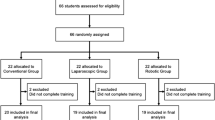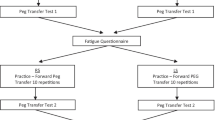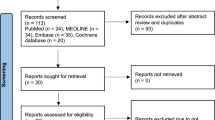Abstract
Background
General Surgery is currently the fastest growing specialty with regards to robotic surgical system utilization. Contrary to the experience in laparoscopy, simulator training for robotic surgery is not widely employed partly because robotic surgical simulators are expensive. We sought to determine the effect of a robotic simulation curriculum and whether robotic surgical skills could be derived from those psychomotor skills attained in laparoscopic training.
Methods
Twenty-seven trainees with no prior robotic experience and limited laparoscopy exposure were randomly assigned to one of three training groups: no simulator training, training on a fundamentals of laparoscopic surgery (FLS™) standard box trainer, and training on a robotic computer based simulator (da Vinci Skills Simulator™). Baseline robotic surgical skills were assessed on the clinical robot docked to a standard FLS trainer box on two tasks—intracorporeal knot tying and peg transfer. Subjects subsequently underwent four 1-h long training sessions in their assigned training environment over a course of several weeks. Robotic surgical skills were reassessed on the robot on the same two tasks used to assess skills prior to training.
Results
FLS training resulted in a greater score improvement than no training for both knot and peg scores. FLS training was also determined to result in greater score improvement than robotic simulator training for knot tying. There was no significant difference in peg transfer or knot tying scores when comparing robotic simulator training and no training.
Conclusions
Robotic surgical skills can be in part derived from psychomotor skills developed in a laparoscopic trainer, especially for complex skills such as intracorporeal knot tying. Acquisition of robotic surgical skills may be enhanced by practice on a laparoscopic simulator using the FLS curriculum. This may be especially helpful when a robotic simulator is not available or is poorly accessible.


Similar content being viewed by others
Abbreviations
- dVSS:
-
da Vinci Skills Simulator™
- FLS:
-
Fundamentals of Laparoscopic Surgery™
References
Pinkerton S (2013) The pros and cons of robotic surgery. Wall Street Journal, Published 17 Nov 2013
Yoo B-E, Cho J-S, Shin J-W, Lee D-W, Kwak J-M, Kim J, Kim S-H (2015) Robotic versus laparoscopic intersphincteric resection for low rectal cancer: comparison of the operative, oncological, and functional outcomes. Ann Surg Oncol 22:1219–1225
Economopoulos KP, Theocharidis V, McKenzie TJ, Sergentanis TN, Psaltopoulou T (2015) Robotic versus laparoscopic roux-en-y gastric bypass: a systematic review and meta-analysis. Obes Surg 25:2180–2189
Bric JD, Lumbard DC, Frelich MJ, Gould JC (2016) Current state of virtual reality simulation in robotic surgery training: a review. Surg Endosc 30:2169–2178
Korets R, Mues AC, Graversen JA, Gupta M, Benson MC, Cooper KL, Landman J, Badani KK (2011) Validating the use of the Mimic dV-trainer for robotic surgery skill acquisition among urology residents. Urology 78(6):1326–1330
Lerner MA, Ayalew M, Peine WJ, Sundaram CP (2010) Does training on a virtual reality robotic simulator improve performance on the da Vinci Surgical System? J Endourol 24(3):467–472
Connolly M, Seligman J, Kastenmeier A, Goldblatt M, Gould JC (2014) Validation of a virtual reality-based robotic surgical skills curriculum. Surg Endosc 28:1691–1694
Bric J, Connolly M, Kastenmeier A, Goldblatt M, Gould JC (2014) Proficiency training on a virtual reality robotic skills curriculum. Surg Endosc 28:3343–3348
Anderberg M, Larsson J, Kockurn CC, Arnbjörnsson E (2010) Robotics versus laparoscopy—an experimental study of the transfer effect in maiden users. Ann Surg Innov Res 6(4):3. https://doi.org/10.1186/1750-1164-4-3
Chandra V, Nehra D, Parent R, Woo R, Reyes R, Hernandez-Boussard T, Dutta S (2010) A comparison of laparoscopic and robotic assisted suturing performance by experts and novices. Surgery 147(6):830–839. https://doi.org/10.1016/j.surg.2009.11.002
Panait L, Shetty S, Shewokis PA, Sanchez JA (2014) Do laparoscopic skills transfer to robotic surgery? J Surg Res 187(1):53–58. https://doi.org/10.1016/j.jss.2013.10.014
Thomaier L, Orlando M, Abernethy M, Paka C, Chen CC (2016) Laparoscopic and robotic skills are transferable in a simulation setting: a randomized controlled trial. Surg Endosc 31(8):3279–3285
Liu M, Curet M (2015) A review of training research and virtual reality simulators for the da Vinci Surgical System. Teach Learn Med 27(1):12–26. https://doi.org/10.1080/10401334.2014.979181
Abboudi H, Khan MS, Aboumarzouk O, Guru KA, Challacombe B, Dasgupta P, Ahmed K (2012) Current status of validation for robotic surgery simulators—a systematic review. BJU Int 111(2):194–205. https://doi.org/10.1111/j.1464-410X.2012.11270
Bric JD, Lumbard DC, Frelich MJ, Gould JC (2016) Current state of virtual reality simulation in robotic surgery training: a review. Surg Endosc 30:2169–2178. https://doi.org/10.1007/s00464-015-4517-y
Hanzly MI, Al-Tartir T, Raza SJ, Khan A, Durrani MM, Fiorica T, Ginsberg P, Mohler JL, Kuvshinoff B, Guru KA (2015) Simulation-based training in robot-assisted surgery: current evidence of value and potential trends for the future. Curr Urol Rep 16(6):41. https://doi.org/10.1007/s11934-015-0508-8
Moglia A, Ferrari V, Morelli L, Ferrari M, Mosca F, Cuschieri A (2016) A systematic review of virtual reality simulators for robot-assisted surgery. Eur Urol 69(6):1065–1080. https://doi.org/10.1016/j.eururo.2015.09.021
Kiely DJ, Gotlieb WH, Lau S, Zeng X, Samouelian V, Ramanakumar AV, Zakrzewski H, Brin S, Fraser SA, Korsieporn P, Drudi L (2015) Virtual reality robotic surgery simulation curriculum to teach robotic suturing: a randomized controlled trial. J Robotic Surg 9:179–186. https://doi.org/10.1007/s11701-015-0513-4
Gomez PP, Willis RE, Van Sickle KR (2015) Development of a virtual reality robotic surgical curriculum using the da Vinci Si surgical system. Surg Endosc 29:2171–2179. https://doi.org/10.1007/s00464-014-3914-y
Stegemann AP, Ahmed K, Syed JR, Rehman S, Ghani K, Autorino R, Sharif M, Rao A, Shi Y, Wildling GE, Hassett JM, Chowriappa A, Kesavadas T, Peabody JO, Menon M, Kaouk J, Guru KA (2013) Fundamental skills of robotic surgery: a multi-institutional randomized controlled trial for validation of a simulation-based curriculum. Urology 81(4):767–774. https://doi.org/10.1016/j.urology.2012.12.033
Jalink MB, Goris J, Heineman E, Pierie JP, Cate Hoedemaker HO (2014) The effects of video games on laparoscopic simulator skills. Am J Surg 208(1):151–156. https://doi.org/10.1016/j.amjsurg.2013.11.006
Heemskerk J, van Gemert WG, de Vries J, Greve JW, Bouvy ND (2007) Learning curves of robot-assisted laparoscopic surgery compared with conventional laparoscopic surgery: an experimental study evaluating skill acquisition of robot-assisted laparoscopic tasks compared with conventional laparoscopic tasks in inexperienced users. Surg Laparosc Endosc Percutan Tech 17:171–174
Acknowledgements
This material is the result of work supported with resources and the use of facilities at the Clement J. Zablocki Veterans Affairs Medical Center.
Funding
This study was funded by the Veterans Administration.
Author information
Authors and Affiliations
Corresponding author
Ethics declarations
Conflict of interest
Dr. Goldblatt reports consulting and speaking fees from Medtronic, Inc, grants from Davol, Inc, consulting and speaking fees from WL Gore, Inc, and research grants from Merck, Inc, all outside the submitted work. Dr. Gould receives speaking fees from WL Gore, Inc and consulting fees from Torax Medical, all outside the submitted work. Dr. Davila, Mrs. Helm, and Mr. Frelich report no conflicts of interest.
Rights and permissions
About this article
Cite this article
Davila, D.G., Helm, M.C., Frelich, M.J. et al. Robotic skills can be aided by laparoscopic training. Surg Endosc 32, 2683–2688 (2018). https://doi.org/10.1007/s00464-017-5963-5
Received:
Accepted:
Published:
Issue Date:
DOI: https://doi.org/10.1007/s00464-017-5963-5




